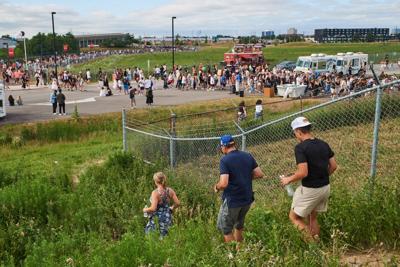It’s the piece of advice almost everyone gets on their way to an important job interview: you only get to make a first impression once.
By that folksy logic, Rogers Stadium failed with flying colours. The bleachers swayed. Many attending last week’s high-profile show, Coldplay, struggled not only to reach the remote venue — situated at the north end of the main runway at the decommissioned Downsview Airport — but also to get home afterwards, when some transit service had already stopped.
Up on stage on successive nights, Coldplay’s adorable frontman Chris Martin dissed a venue that had been purpose-built to accommodate the group’s four-night residency, then tried to walk back his criticisms. By that point, of course, the reputational damage had been done.
The new venue, however, isn’t the first time Downsview’s potential has been bruited. Years before the city decided to build Skydome on a downtown site with plenty of transit access but little parking, some local politicians were pushing to build a new stadium for the Blue Jays, the Argos and potentially an NFL franchise at Downsview.
The late mayor Mel Lastman for a while fronted a strange scheme to build a techno-theme park there. And Jean Chretien’s government in the mid-1990s re-designated a large chunk of the base as Canada’s first national urban park. Three decades on, Parc Downsview Park has yet to live up to the early hype or attract the kind of development that was meant to underwrite its operations.
Before the current stadium was completed, the TTC ordered up free service home for concert-goers, and there’s little doubt that Metrolinx, which came in for plenty of grief for failing to coordinate its Downsview GO service with the end of the show, will alter its schedules.
But the problem be-devilling Rogers Stadium, a joint venture between Live Nation and Northcrest, the development arm of a major public sector pension fund that owns the 400-acre site, isn’t about getting the train times right. Coordinated scheduling should be table stakes. Yet the venue’s success turns on cracking a locational riddle that has dogged a vast tract of real estate that has long intrigued politicians, developers and promoters.
The latest effort to redevelop Downsview is Northcrest’s long-term strategy, dubbed YZD, to build thousands of new homes and apartments, retail venues and offices there. Northcrest’s urban design plan is organized around a central artery that aligns with the main runway, but also aims to take advantage of the four rapid transit stations — three subway stops and a co-located GO station — situated around the edges of the site.Â
The stadium, which sits in the middle of this proposed development, is all about monetizing this real estate until Northcrest is ready to build, but also getting ÎÚŃ»´«Ă˝nians accustomed to going to Downsview, with its apparently abundant transit resources. Writ large, it’s a similar tactic downtown developers use when they conjure up little markets or art venues on cleared parcels that will someday house a high-rise.
The problem with Downsview is it’s so vast that such calculations, which work in denser parts of the city, don’t apply. The actual walking time between the stadium and the four transit stops is considerable (15-20 minutes, and more to Wilson Station); the landscape, bleak and treeless. After all, you have to traverse a former airport the size of High Park but with none of the charm.
While the transit scheduling will improve, the stadium’s geographical isolation won’t change anytime soon. Fine for much sought-after concerts, but it’s not going to become more than a special outing destination at the far end of a dreary schlep — something SARSstock attendees discovered in 2003, when thousands had to walk down the Allan Expressway to get home.Â
The city-building lesson of both Skydome and ScotiaBank Arena is that the downtown did, as planned, grow up around these once isolated venues, filling in space formerly occupied by railways. Yet the infill, with City Place and Southcore, occurred because those brownfields were already close to the urbanized core, the waterfront and transit.
Downsview’s dilemma, as yet unresolved, is that it is surrounded by a moat of arterial roads, high fences and storage yards, without an internal street grid except the legacy air force base roads that lead to recreational and commercial venues fitted out with plenty of parking. (Those lots aren’t currently available to concert-goers and the stadium organizers that a limited amount of surface parking is available near the subway stations.)Â
Access to rapid transit is necessary to someday urbanize this massive space, but the four stations on Downsview’s periphery are not sufficient, as Coldplay fans discovered last week. Indeed, our new 50,000-seat concert venue may draw hundreds of thousands of ÎÚŃ»´«Ă˝nians to the remote centre of a derelict airport. But whether they fall in love with the urban potential of what they see all around it seems highly unlikely, at least for the foreseeable future.























To join the conversation set a first and last name in your user profile.
Sign in or register for free to join the Conversation